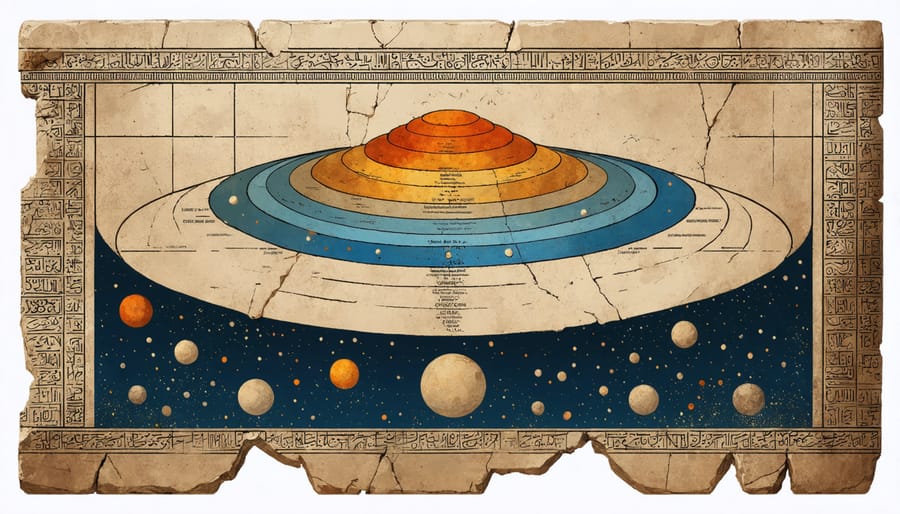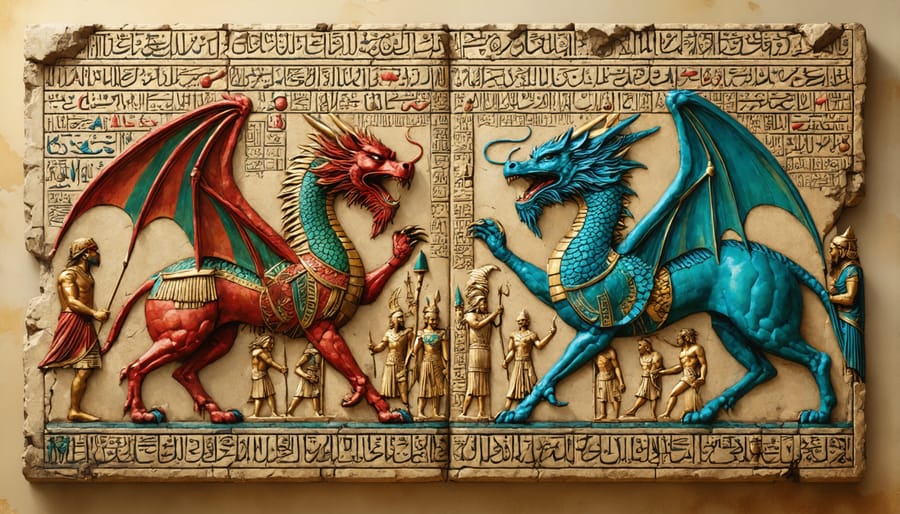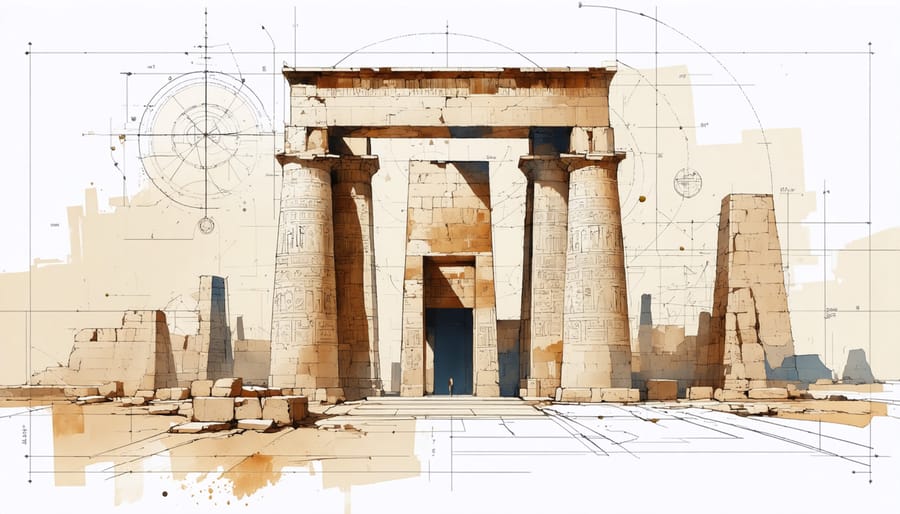When ancient Israelites gazed at the stars or pondered the structure of their world, they shared a cosmic vision with their Near Eastern neighbors that deeply influenced their biblical interpretation. This ancient understanding of the universe, while different from our modern scientific view, reveals profound spiritual truths that continue to resonate with believers today. The cosmology of the ancient Near East imagined the world as a three-tiered structure: the heavens above, the earth in the middle, and the waters below. Rather than diminishing our faith, this cultural context enriches our appreciation of Scripture’s divine message. When we read about the “waters above the firmament” in Genesis or the “pillars of the earth” in Job, we’re encountering powerful metaphors that spoke directly to the ancient audience while conveying timeless truths about God’s sovereignty and creative power. Understanding this ancient worldview helps us bridge the gap between their perspective and ours, deepening our connection to Scripture’s eternal message while honoring its historical context.
The Ancient Near Eastern Worldview
The Three-Tiered Universe
Ancient Near Eastern peoples understood their world through a three-tiered structure that has been confirmed by numerous archaeological discoveries. They envisioned the universe as consisting of three distinct realms: heaven above, earth in the middle, and the underworld below. This worldview appears throughout the Old Testament, reflecting the cultural context in which God chose to reveal Himself to His people.
The heavens were seen as God’s dwelling place, often described as being supported by pillars or columns. The earth, where humans dwelt, was viewed as a flat disc floating on a vast cosmic ocean. Below the earth lay the underworld, commonly understood as the realm of the dead.
While this ancient understanding might seem simplistic to modern readers, it’s important to remember that God communicated His truth through language and concepts that His people could understand. Rather than focusing on scientific accuracy, these descriptions served to convey profound spiritual truths about God’s sovereignty over all creation and His intimate involvement with humanity.

Waters Above and Below
In ancient Near Eastern understanding, the cosmos was viewed as being surrounded by waters both above and below the earth. This concept appears in Genesis 1:6-7, where God creates a firmament (or expanse) to separate the waters above from the waters below. The ancient peoples believed that these cosmic waters were held back by divine power, with the sky serving as a solid dome that kept the upper waters from flooding the earth.
This understanding helps explain many biblical passages, such as the mention of “windows of heaven” in Genesis 7:11 during Noah’s flood, and references to God storing waters in heavenly chambers found in Psalms. The waters below were thought to be the source of springs, rivers, and wells, while the waters above were understood to be the source of rain and snow.
Rather than dismissing these descriptions as merely primitive understanding, we can appreciate how they conveyed profound theological truths about God’s sovereignty over creation and His role in sustaining all life through the water cycle He designed.
Common Creation Themes
Order from Chaos
In ancient Near Eastern thought, creation wasn’t simply about making something from nothing – it was about bringing divine order to primordial chaos. This concept deeply resonates with the biblical creation narrative, where God transforms formlessness and void into a beautifully ordered universe. Understanding this within its proper cultural context helps us appreciate the profound meaning behind Genesis’s opening chapters.
The Hebrew word “tohu va-vohu” (formless and void) describes the state before God’s creative work began. Like an artist bringing form to shapeless clay, God separated light from darkness, waters above from waters below, and land from sea. Each act of creation established boundaries, assigned purposes, and brought structure to what was previously disordered.
This ordering principle reflects God’s nature as a God of peace and order, not confusion (1 Corinthians 14:33). The ancient Near Eastern audience would have recognized this powerful theme – that the divine work of creation involves establishing order, setting boundaries, and giving purpose to all things. This understanding enriches our appreciation of God as both the supreme Creator and the one who continues to bring order to chaos in our own lives.
Today, we can find comfort in knowing that the same God who brought order to the universe can bring peace to our chaotic circumstances and purpose to our confusion.

Divine Rest and Temple Building
In ancient Near Eastern thought, the completion of creation was often marked by the establishment of sacred spaces where divine rest could occur. This concept beautifully illuminates our understanding of Genesis, where God’s rest on the seventh day signifies not mere physical relaxation, but the completion of His cosmic temple – the universe itself.
The pattern of divine rest following creative work appears throughout Scripture and ancient Near Eastern texts. Just as earthly kings would build temples and rest in them, God’s rest in Genesis represents His taking up residence in His cosmic temple. This helps us understand why the tabernacle and temple were seen as microcosms of creation – sacred spaces where heaven and earth intersected.
When God rested on the seventh day, He was essentially “moving into” His creation, establishing His dwelling place among what He had made. This profound truth finds its ultimate fulfillment in Jesus Christ, who “tabernacled” among us (John 1:14) and through whom we become living temples of the Holy Spirit.
The connection between creation and sacred space reminds us that God’s purpose has always been to dwell with His people. From Eden to the tabernacle, from Solomon’s temple to the new creation, God’s desire for communion with humanity remains constant. This understanding enriches our worship and deepens our appreciation for how we, as believers, are being built together into a dwelling place for God by the Spirit.

Biblical Distinctives
One God, No Rivals
In stark contrast to the polytheistic worldviews of surrounding ancient Near Eastern cultures, the book of Genesis presents a radically different perspective: there is only one God, and He has no rivals. While other ancient creation accounts depicted gods competing for power and emerging from pre-existing matter, Genesis boldly declares that one supreme God created everything from nothing.
This monotheistic view wasn’t just different—it was revolutionary. The opening words of Genesis, “In the beginning, God created the heavens and the earth,” establish immediately that God exists independently of creation and stands above it as its sovereign maker. Unlike the gods of neighboring cultures who were often associated with and limited to specific natural elements, the God of Genesis demonstrates complete authority over all aspects of creation.
The sun and moon, which other cultures worshipped as deities, are simply described as “lights” that God placed in the sky to serve His purposes. The sea creatures, often depicted as chaos monsters in other ancient texts, are merely creatures that God made and blessed. This deliberate “de-deification” of nature serves to emphasize that there is only one true God worthy of worship.
This unique monotheistic perspective provides the foundation for understanding not just creation, but the entire biblical narrative and God’s relationship with humanity.
Human Dignity and Purpose
In stark contrast to other ancient Near Eastern views, the biblical account presents humans as bearing the image of God, created with inherent dignity and divine purpose. Genesis 1:26-27 establishes humanity’s unique position as God’s representatives on earth, given the responsibility to steward creation and reflect His character.
While other ancient cosmologies often portrayed humans as mere servants or afterthoughts of the gods, created to perform menial tasks, the biblical narrative elevates humanity to a position of profound significance. As image-bearers of God, humans are endowed with creativity, reason, and the capacity for relationship with their Creator.
This special role is further emphasized through the creation account’s portrayal of God personally forming Adam from the dust and breathing life into him. The intimate nature of humanity’s creation stands apart from other ancient Near Eastern stories, where humans were typically created from the blood of slain gods or as an afterthought to serve divine needs.
The biblical understanding of human purpose extends beyond mere existence or survival. Humans are called to be co-creators with God, cultivating the earth, building communities, and participating in God’s ongoing work of redemption. This elevated view of human dignity and purpose continues throughout Scripture, ultimately finding its fullest expression in Christ, who both perfectly displays God’s image and restores humanity’s ability to fulfill their divine calling.
Finding Faith in Ancient Context
Understanding ancient Near Eastern cosmology doesn’t diminish our faith; rather, it enriches our appreciation of how God communicated His truth to His people. When we discover how the biblical authors used familiar cultural concepts to convey God’s message, we witness the beautiful way He meets people where they are. This understanding becomes part of God’s redemptive plan, showing His willingness to speak through human contexts while expressing divine truth.
Consider how Jesus used parables about farming and fishing to teach spiritual truths to His audience. Similarly, God used the cultural understanding of the ancient Near East to reveal His role as Creator and Sovereign Lord. The Bible’s descriptions of creation weren’t meant to provide a scientific textbook but to declare God’s supremacy over all creation in terms His original audience could grasp.
This realization strengthens our faith by highlighting God’s wisdom in revelation. Just as parents adjust their language when speaking to children, God accommodated human understanding to communicate eternal truths. The message remains clear: God is the ultimate Creator and Sustainer of all things, regardless of how ancient peoples pictured the cosmos.
By embracing this perspective, we can focus on the theological truths being conveyed rather than getting caught up in modern scientific debates. This approach allows us to read Scripture as it was intended while maintaining our trust in its divine inspiration.
Understanding ancient Near Eastern cosmology enriches our appreciation of Scripture while strengthening our faith in remarkable ways. By exploring how the biblical authors communicated God’s truth through familiar cultural concepts, we gain deeper insight into His divine accommodation of human understanding. This knowledge doesn’t diminish Scripture’s authority or inspiration but rather highlights God’s wisdom in reaching people where they were.
The similarities between biblical and ancient Near Eastern cosmologies demonstrate how God spoke through familiar cultural frameworks, while the profound differences showcase Scripture’s unique divine message. Where other ancient cultures saw nature as divine, the Bible presents it as God’s creation. Where they saw competing deities, Scripture proclaims one sovereign Creator.
For modern believers, this understanding helps us read the Bible more faithfully, appreciating both its historical context and timeless truth. It reminds us that God continues to meet people where they are, speaking through cultural frameworks they understand. This should encourage us to present biblical truth in ways that connect with our contemporary world while maintaining its essential message.
Most importantly, studying ancient Near Eastern cosmology reveals God’s unchanging character – His desire to communicate with humanity, His patience in working through human understanding, and His ultimate purpose of revealing Himself through His Word. This knowledge invites us to approach Scripture with renewed wonder at God’s wisdom in revealing Himself to all generations.
